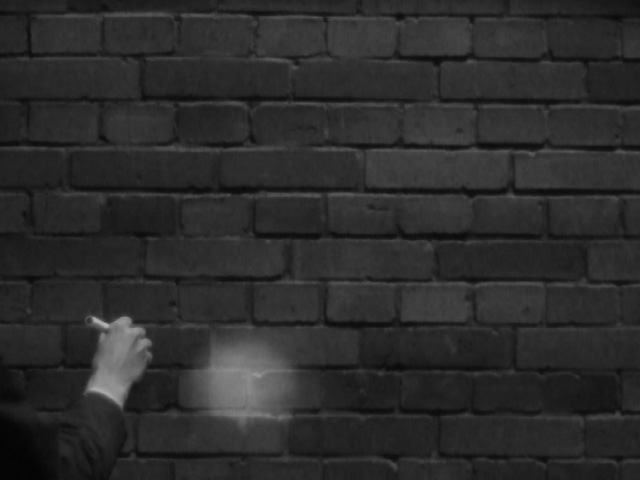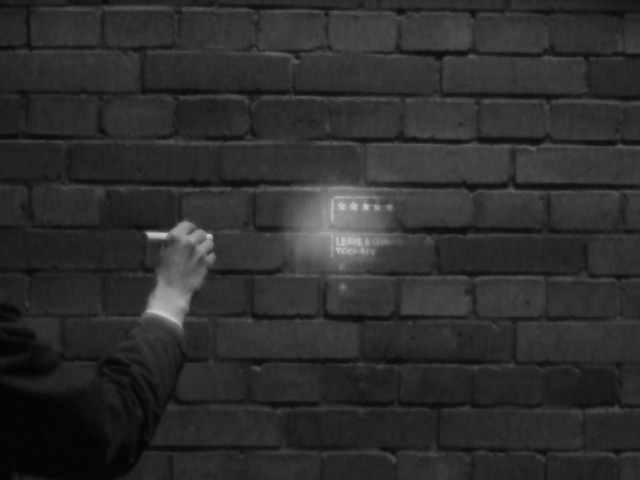Leave-A-Comment-Toolkit

With the Leave-A-Comment-Toolkit an invisible layer of subjective, unauthored, user-generated information is cast on public space in a very accessible and low-tech fashion.



To enable participants to cast an invisible layer of subjective, unauthored information on public space, prepared ›toolkits‹, comprised of an ultraviolet-fluorescent pen (UV-pen), a speech-bubble-shaped stencil, and an ultraviolet-torch (UV-torch) were handed out. The UV-pen and the stencil function as the ›authoring tool‹ while the UV-torch plays the role of the ›imaging device‹. The UV-pen works in a way that allows for leaving a message on a surface, invisible to the human eye, until the message is illuminated with the UV-torch, revealing it fluorescing, temporarily visible to the human eye.

Equipped with the toolkit participants now tag, flag, or comment on things, spaces and places by invisibly but physically writing or drawing on them. Eventually the invisible layer grows into a secret parallel world, with messages potentially lurking in corners, comments unknowingly on display right in front of one’s face, subversively augmenting public space.

As an add-on we have conceived a mobile application that functions as a comment-finding-aid. After having left a comment, participants take a photo, upload it, tagged with a geolocation, to the Leave-A-Comment website.

With this project three issues are raised.
Information Sovereignty in Public Spaces
Several streetart movements already address the issue of information sovereignty in public spaces. We would like to add another perspective to it: How do we deal with information that is there but not visible? Does it affect us? Does it offend us? Is it illegal if a substance can be traced chemically but not visually? We believe that we hint towards a strategy to undermine the proprietary information politics defining our ( urban ) environments. ( A predecessor/prototype to this project was a disfunctional pen, made out of cardboard, containing no ink, we used to pretend to write on surfaces, essentially adressing a related question. )
A Proposal for an Alternative View on Everyday Life
Apart from political considerations we found that the notion of an invisible information layer stretching over our everyday environments has a deep philosophical and poetic dimension. What else, apart from the UV-ink, don’t we see, that is physically surrounding us? How would we react if we suddenly find out that the entire street we lived has been paint with invisible ink, years ago? We found ourselves more then once ›scanning‹ our surroundings with the UV-torch in hope to find some secret unseen message.
Technological Empowerment
Although fascinated by ›Augmented Reality‹ and it’s community building capabilities we are irritated by the technological threshold it imposes on the potential user. By ›de-tech-ing‹ the principle down to its essential mechanics we believe that we contribute a meaningful comment on this condition. ( we are well aware of the fact that the ›comment-finding-aid‹ introduces a high-tech component to the projects; since the aid is no integral part of the project we accept this conceptual inaccuracy. )
Certain Rules of Conduct were suggested.
Do This
We compiled a list of hints that we consider to be a good starting point for you.
- Keep the drawing device clean, otherwise it will leave a visible trace.
- Use the UV-TORCH to check on what you are drawing, while you are drawing.
- Try to put yourself into the head of the others. Set them up, play a prank on them, anticipate their behavioral patterns.
- Document people discovering hidden information, your information.
- Contemplate the surfaces and objects you will draw upon. What do they mean to you? What do they mean to others. In other words try to avoid spam. Having said that we are also committed to the notion of ›One man’s spam is another man’s treasure‹.
- Obviously writing is a very powerful cultural tool, but you should also consider using your tools to reveal or amplify structures and patterns that already exist in situ and are unique to the place you draw in.
- Try to place messages in a place where they can be found. If you choose an inaccessible place, choose it for a reason.
- We have found that the UV-TORCH works best in twilight or darkness.
Do Not Do This
Obviously this project plays with illegality and raises one or two question about ›Informationshoheit (information sovereignty)‹ in public space. Try your best to keep it legal; on the edge, but legal. We have compiled a list of things you shouldn’t do. If you choose to do them anyway, you are on your own and even we might hate you afterwards.
- Don’t support vandalism, we won’t.
- Don’t destroy or ruin anything that means something to someone by drawing on it.
- Don’t draw on surfaces and materials that get damaged by the ink.
- Don’t draw on animals, humans and other living things that can’t deal with the ink or havn’t specifically agreed to be drawn upon.
- Don’t draw on things that someone will eat afterwards.
- Don’t swallow the ink or the pen.
- Don’t point the light into your or any eye.
- Don’t cause too much of a fuzz when drawing. The fuzz will be automatically created afterwards.
- Don’t seriously offend or insult anyone with what you draw. Respect other people, as they hopefully respect you.
It is a game. Play it.
Games have rules. Play it fair.
Even if you won’t, sign this with your blood.
One fine afternoon Linus and Linda agreed to leave a few comments in Berlin Kreuzberg …



